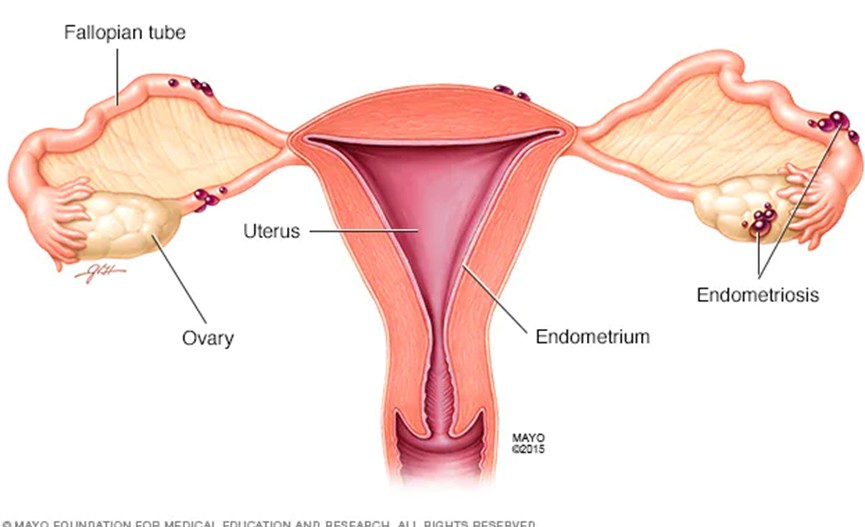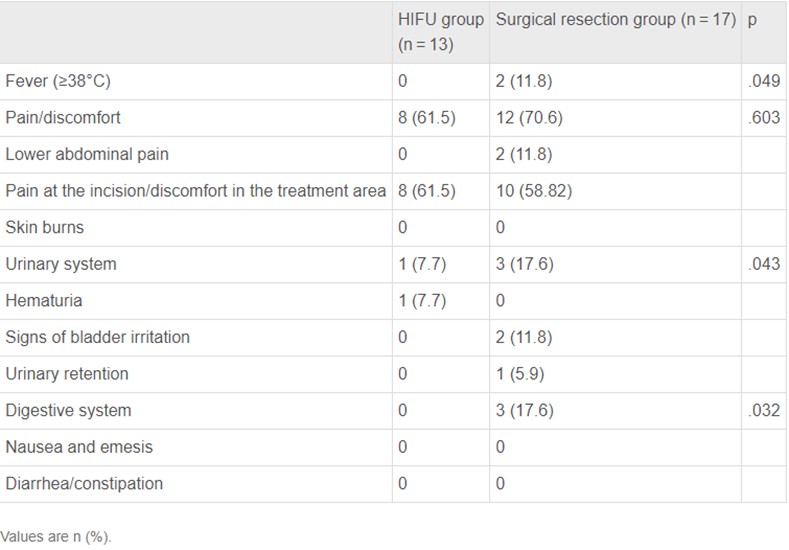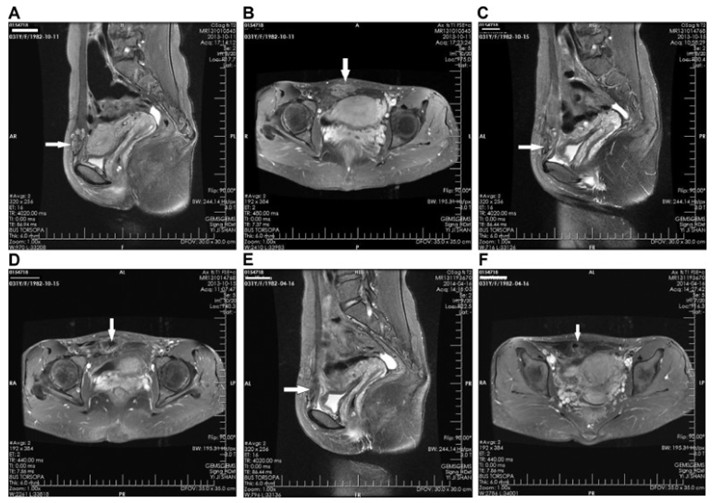About

Endometriosis is an often painful disorder in which tissue similar to the tissue that normally lines the inside of your uterus — the endometrium — grows outside your uterus. Endometriosis most commonly involves your ovaries, fallopian tubes and the tissue lining your pelvis. Rarely, endometrial-like tissue may be found beyond the area where pelvic organs are located.
With endometriosis, the endometrial-like tissue acts as endometrial tissue would — it thickens, breaks down and bleeds with each menstrual cycle. But because this tissue has no way to exit your body, it becomes trapped. When endometriosis involves the ovaries, cysts called endometriomas may form. Surrounding tissue can become irritated, eventually developing scar tissue and adhesions — bands of fibrous tissue that can cause pelvic tissues and organs to stick to each other.
Endometriosis can cause pain — sometimes severe — especially during menstrual periods. Fertility problems also may develop. Fortunately, effective treatments are available.
Current Treatment Methods
Surgical resection is the most common treatment for AWE. Wide excision with at least 1 cm of a clear margin is advocated to prevent local recurrence. However, the procedure causes further operative trauma and scars. For large lesions, especially those involving both muscle and fascia, synthetic mesh placement may be needed to strengthen the abdominal wall to prevent postoperative hernia that would induce further pain and economic burden. High-intensity focused ultrasound (HIFU) is a non-invasive treatment method that induces coagulation necrosis of the target tissues in vivo via ultrasound waves without injuring the adjacent normal tissues, Recently, HIFU has been widely used for the treatment of uterine fibroids and endometriosis.
What are the benefits of HIFU?
◼ It is non invasive, which means faster recovery comparing to surgery
◼ Only sedation, no anesthesia required
◼ Precise ablation without damaging the surrounding myometrium
◼ Lower treatment risks
Am I suitable to undergo HIFU?
Suitable Indications:
◼ AWE diagnosed via ultrasound or magnetic resonance imaging (MRI)
◼ Clear ability to communicate with the physician and nurse
◼ No operation of the abdominal wall over the past 3 months, especially liposuction
◼ Patients don't have severe comorbidities, such as cardiopathy, hypertension, or diabetes
◼ Patients could tolerate 2–3h in a prone position
*Please be noted the above criteria is only for reference, whether a patient can be applied HIFU shall be further confirmed by HIFU doctors after diagnosis.
Contraindications:
◼ Inflammation or ulceration of the skin in or near the nodule
◼ Suspected or confirmed malignancy
◼ Unsafe acoustic pathway
◼ Abnormal or unstable vital signs
Effectiveness of HIFU
Symptom Relief
Studies of recent years have shown that the management of HIFU in AWE is safe and effective. For example, based on a single-center study on 51 AWE patients, at 48 months of follow-up, no patient had periodic pain. Their VAS scores significantly decreased from 1.00 ± 1.41 at 1 month and 1.00 ± 1.41 at 6 months to 0.5 ± 0.711 at 12 months and 0.00 ± 0.00 at 24, 36 and 48 months. In addition, the rate of decrease in volume increased from 25.34 ± 18.83% at 1 month to 81.89 ± 15.69% at 6 months, 96.16 ± 5.44% at 12 months to 85.25 ± 20.86% at 24 months, 85.40 ± 20.60% at 36 months and to 100.00 ± 0.00% at 48 months.
In another study, according to a 24-month follow-up among a total of 30 AWE patients treated with HIFU, the pain experience by all patients disappeared, while the VAS significantly decreased from 1.39 ± 1.32 in 1 month, 0.63 ± 0.87 in 6 months, 0.27 ± 0.59 in 12 months, and 0.00 ± 0.00 in 24 months. In addition, the rate of shrink volume significantly increased, from 40.70 ± 24.00 in 1 month, 92.40 ± 12.10 in 6 months, 97.88 ± 6.56 in 12 months, and 100 ± 0.00 in 24 months.
1. Xiao-Ying Z, Hua D, Jin-Juan W, Ying-Shu G, Jiu-Mei C, Hong Y, Chun-Yi Z. Clinical analysis of high-intensity focussed ultrasound ablation for abdominal wall endometriosis: a 4-year experience at a specialty gynecological institution. Int J Hyperthermia. 2019;36(1):87-94. doi: 10.1080/02656736.2018.1534276. Epub 2018 Nov 14. PMID: 30428731.
2. Zhang X, Duan H. Effect of high-intensity focused ultrasound ablation on endometriosis of the abdominal wall. Int J Clin Exp Pathol. 2018 Apr 1;11(4):2118-2124. PMID: 31938321; PMCID: PMC6958225.
Safety of HIFU
Common adverse events after HIFU in the management of AWE include pain/discomfort in the treatment area, lower abdominal pain, and skin burn.
A study on evaluating the safety and effectiveness of HIFU for AWE shows that adverse effects within 24 hours post-procedure of 30 patients are as followed:

Showing relatively low incidence risk.
Shi S, Ni G, Ling L, Ding H, Zhou Y, Ding Z. High-Intensity Focused Ultrasound in the Treatment of Abdominal Wall Endometriosis. J Minim Invasive Gynecol. 2020 Mar-Apr;27(3):704-711. doi: 10.1016/j.jmig.2019.06.012. Epub 2019 Jun 27. PMID: 31255787.
Case Study

MRI of another 31-year-old patient with AWE treated with HIFU ablation.
(A) Before HIFU ablation MRI showed slightly mixed signals with small cystic hyperintensity within the lesion on the T2-weighted image.
(B) Before HIFU ablation remarkable enhancement was observed on the contrast-enhanced T1-weighted image.
(C) One day after HIFU ablation the treated lesion showed hypointensity on the T2-weighted image. (D) One day after HIFU ablation no enhancement was seen in the treated lesion on the contrast-enhanced T1-weighted image.
(E) Six months after HIFU ablation the treated lesion decreased obviously on the T2-weighted image.
(F) Six months after HIFU ablation the treated lesion decreased on the contrast-enhanced T1-weighted image.
Shi S, Ni G, Ling L, Ding H, Zhou Y, Ding Z. High-Intensity Focused Ultrasound in the Treatment of Abdominal Wall Endometriosis. J Minim Invasive Gynecol. 2020 Mar-Apr;27(3):704-711. doi: 10.1016/j.jmig.2019.06.012. Epub 2019 Jun 27. PMID: 31255787.